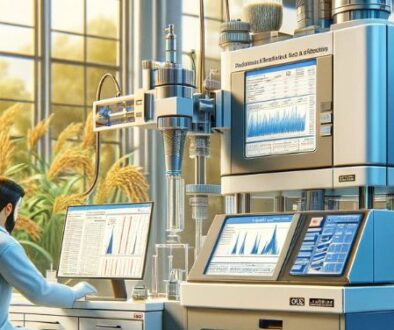Risk Analysis Of Heavy Metal Arsenic Contamination In Rice From Different Origins In Yunnan Province
Analyzing arsenic contamination in Yunnan rice: significance, regional disparities, high-risk areas, and recommendations for mitigating heavy metal pollution.
Objective To analyze the contamination risk of heavy metal arsenic in rice from different origins in Yunnan Province. Methods An LC-AFS6500 atomic fluorescence photometer was used to analyze the inorganic arsenic content of 2592 rice samples collected from 118 counties (cities/districts) in the main rice-producing areas of 16 prefectures (cities) in Yunnan Province, and correlation analysis and variance were performed. Analysis and LSD multiple comparisons. Results: The average inorganic arsenic content of the test samples was 0.028 mg/kg, among which, farmland around industrial and mining enterprises (0.036 mg/kg)>general farmland (0.026 mg/kg)>sewage irrigated farmland (0.021 mg/kg), with industrial and mining areas The farmland surrounding the company has the greatest risk of heavy metal arsenic pollution. After analysis of variance, the F value was 16.994, showing a very significant difference. The inorganic arsenic content in farmland surrounding industrial and mining enterprises and farmland irrigated with sewage was highest in Honghe Prefecture, at 0.128 and 0.055 mg/kg respectively. In general farmland, Lijiang City had the highest content at 0.078 mg/kg, which was the same as in all other prefectures (cities). ) showed extremely significant differences; the mean value of inorganic arsenic in Pu’er City was the smallest among the 16 states (cities), and the detection rate was the lowest; among 2592 samples, 13 samples had inorganic arsenic content exceeding the limit, accounting for 0.50 of the samples tested %, all collected from Honghe Prefecture, including 6 samples from Gejiu City, 5 samples from Mengzi City and 2 samples from Kaiyuan City. Conclusion The agricultural ecological environment is an important factor affecting heavy metal arsenic pollution in rice. It is recommended that heavy metal arsenic pollution in farmland surrounding industrial and mining enterprises should be paid special attention to.
Introduction to Arsenic Contamination in Rice
The pervasive issue of arsenic contamination in rice, a staple food consumed by millions globally, has garnered significant attention due to its potential health risks. In Yunnan Province, a study was conducted to analyze the contamination risk of heavy metal arsenic in rice originating from various locales, utilizing a comprehensive and methodological approach to ensure the validity and reliability of the results. This research aimed to provide a clearer understanding of arsenic contamination levels across different types of farmland and identify specific areas at greater risk, thereby facilitating targeted interventions to mitigate these risks.
Study Methodology and Sample Analysis
Utilizing the LC-AFS6500 atomic fluorescence photometer, a total of 2592 rice samples were analyzed. These samples were collected from 118 counties (cities/districts) within the main rice-producing regions of 16 prefectures (cities) in Yunnan Province. The study employed rigorous statistical methods, including correlation analysis, variance analysis, and LSD multiple comparisons, to assess the inorganic arsenic content across these samples.
Results: Variance in Arsenic Content by Farmland Type
The findings revealed an average inorganic arsenic content of 0.028 mg/kg among the tested samples. Notably, the arsenic content varied significantly depending on the farmland’s proximity to industrial and mining enterprises, as well as the irrigation methods employed. Farmland situated near industrial and mining enterprises exhibited the highest contamination risk, with an average arsenic content of 0.036 mg/kg. This was followed by general farmland (0.026 mg/kg) and sewage-irrigated farmland (0.021 mg/kg), highlighting the influence of agricultural practices and environmental factors on arsenic accumulation in rice.
Regional Disparities in Arsenic Contamination Levels
A further breakdown of the results indicated that Honghe Prefecture faced the most severe contamination, particularly in farmland adjacent to industrial and mining enterprises and sewage-irrigated farmland, with arsenic levels reaching 0.128 mg/kg and 0.055 mg/kg, respectively. Lijiang City emerged as the area with the highest arsenic content in general farmland, at 0.078 mg/kg. These findings underscore the significant disparities in arsenic contamination across different regions and the need for localized assessments to address these risks effectively.
Statistical Significance and Analysis of Variance
The variance analysis underscored the substantial differences in arsenic levels across the studied areas, with an F value of 16.994 indicating a highly significant variance. This further validates the concern that arsenic contamination is not uniformly distributed but rather influenced by specific environmental and agricultural conditions.
Identification of High-Risk Areas for Arsenic Contamination
Among the samples analyzed, 13 exceeded the safe limit for inorganic arsenic content, representing 0.50% of the total. These samples were all sourced from Honghe Prefecture, emphasizing the acute contamination risk in this area and the urgent need for remedial actions to protect public health.
Conclusion and Recommendations for Mitigation
In conclusion, this study highlights the critical role of the agricultural ecological environment in influencing heavy metal arsenic pollution in rice. The findings suggest a pressing need for heightened surveillance and intervention measures, particularly in farmland surrounding industrial and mining enterprises, to mitigate the contamination risk and safeguard food safety. Policymakers, agricultural stakeholders, and environmental agencies must collaborate to address this issue proactively, employing both preventive and remedial strategies to ensure the health and well-being of the population.
For futher details of this article and research, feel free to contact our team for assistance.
About ETprotein:
ETprotein, a reputable plant protein vegan protein Chinese factory manufacturer and supplier, is renowned for producing, stocking, exporting, and delivering the highest quality organic bulk vegan protein and plant proteins. They include Organic rice protein, clear rice protein, pea protein, clear pea protein, oat protein, watermelon seed protein, pumpkin seed protein, sunflower seed protein, mung bean protein, peanut protein, various of plant peptides etc. Their offerings, characterized by a neutral taste, non-GMO, allergen-free attributes, cater to a diverse range of industries. They serve nutraceutical, pharmaceutical, cosmeceutical, veterinary, as well as food and beverage finished product distributors, traders, and manufacturers across Europe, USA, Canada, Australia, Thailand, Japan, Korea, Brazil, and Chile, among others.
ETprotein specialization includes exporting and delivering tailor-made protein powder and finished nutritional supplements. Their extensive product range covers sectors like Food and Beverage, Sports Nutrition, Weight Management, Dietary Supplements, Health and Wellness Products, and Infant Formula, ensuring comprehensive solutions to meet all your protein needs.
As a trusted company by leading global food and beverage brands and Fortune 500 companies, ETprotein reinforces China’s reputation in the global arena. For more information or to get a free sample of their protein products, please contact them and email sales(at)ETprotein.com today.












